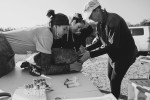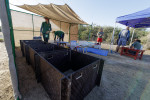In-Water Monitoring of Juvenile Green Turtles at Al Qurm Reserve: A Unique Development Area for Turtles in the United Arab Emirates

© John Pereira – EPAA Sharjah
By Jimena Rodriguez, John Pereira and Brendan Whittington-Jones
Environment and Protected Areas Authority (EPAA), Sharjah, United Arab Emirates
The mangrove system of Al Qurm Protected Area is located in the city of Kalba in the Emirate of Sharjah on the Gulf of Oman coast of the UAE. Declared as a protected area in 2012, it was recognised a year later by the Convention on Wetlands of International Importance (Ramsar) as an area of importance for endangered species, including among others the Arabian collared kingfisher (Todiramphus chloris kalbaensis) an endemic subspecies to the Emirate of Sharjah and breeding resident of the reserve (Cambell et al., 2012).
In recent years, biodiversity surveys conducted in Al Qurm by the Environment and Protected Areas Authority Sharjah (EPAA), showed the sustained presence of green turtles (Chelonia mydas) in large numbers (up to 200 individuals reported in 2018), indicating that the reserve could play an important ecological role offering food and shelter to green turtles in early life stages. It is likely a development area for turtles to grow until they are big enough to recruit to adult feeding areas across the region. In 2018, the Arabian green turtle population was assessed as Vulnerable (IUCN Red List Assessment, 2018) due to the increase on threats to their survival linked to incidental mortality on fishery operations, marine pollution and loss of feeding and nesting habitat due to coastal development highlighting the importance of focused action.
This discovery placed the Al Qurm mangroves on the map as a priority area for conservation of green turtles in the UAE. As a result, the Al Qurm in-water monitoring, research and conservation programme for marine turtles led by EPAA was established in 2020, making it the only ongoing monitoring programme in the country focusing on the surveying of turtles at feeding grounds. Before the formal establishment of the programme, tagging efforts were conducted in collaboration with Emirates Nature-WWF, as part of a wider initiative for understanding migration patterns of green turtles in the Arabian region. This started with the attachment of a satellite tracker to a juvenile turtle in Kalba in 2018. The information collected suggested the frequent use of the mangrove channels of the reserve by the turtle and helped motivate for the scaling up of the research initiative. Data retrieved from the fitment of trackers on 11 more turtles in 2019 enabled the characterisation of key spatial habitat information that contributed to the provisional extension of the boundaries of the reserve. These initial efforts were the stimulus for the later establishment of the in-water monitoring programme that followed.
One of the successes of the programme have come through the use of Unmanned Aerial Vehicle (UAV) or drone technology which initially allowed us to confirm the presence of turtles in the Al Qurm mangrove area, and later set the foundation for initiatives looking at understanding the relationship of turtles with this habitat. Using UAV technology we continue to monitor turtle’s abundance and its spatial distribution in the mangrove channels to identify hotspot areas used by young turtles. In addition, its use has been a key for supporting turtle’s surveys as we coupled this technology to the capture of turtles via entanglement netting (Ehrhart & Ogren, 1999) therefore making it more efficient by reducing netting times and safer for turtles by ensuring a quick response for disentanglement of turtles from the net.
Once captured, biometrics and body conditions of turtles are recorded after which they are processed for individual identification through a combination of mark-recapture methods: tagging of turtles with Inconel Flipper tags and Passive Integrated Transponder Tags (PIT tags), DNA fingerprinting, and facial recognition through photo Identification. Blood samples are collected to validate sex identification, and enable assignment of individuals to neighbouring nesting areas, health screening and toxicology assessments. Combining traditional and novel approaches and scientific methods the programme aims to assess and monitor the abundance, status, health, and population dynamics and structure of juvenile green turtles at Al Qurm Protected Area, in addition to identifying threats to turtles’ survival.
Since the start of the programme 46 individuals have been surveyed, with the smallest turtle recorded measuring 35.1 cm in Curve Carapace Length (CCL) and the largest CCL = 59.5 cm, confirming that the area is mostly used by juvenile immature green turtles (juvenile (< 65 cm CCL), subadult (65-86 cm CCL), and adult-sized (> 86 cm CCL); Jensen et al., 2020). We expect that our ongoing monitoring programme will generate more detailed information over time on this and other aspects of the ecology of green turtles in the region. Monitoring surveys using drones are conducted seasonally during summer (April – Sept) and supplemented by physical capture in winter (Oct-March) by a multidisciplinary team of biologists, marine ecologists, and veterinarians from EPAA with the support of volunteers.
Regionally, little is known about the ecology, and population dynamics of this particular life stage of sea turtles, a critical development phase needed to sustain sea turtle populations over time as new individuals recruit to the wider population. Therefore, understanding how juvenile turtles utilise the foraging and development area of Al Qurm, will yield better estimates of population abundance year-upon-year, residency times, growth rates and overall habitat use by immature green turtles. Answering these and other relevant ecological and biological questions will enable science-based conservation planning and management, further motivate regional conservation efforts for the protection of these species, and supplement regional population trend assessments that usually lack information from different turtle life-stages at sea.
References:
Cambell, O., Al Ali, A., & Tovey, N. (2012). The status of Collared Kingfisher in the United Arab Emirates, with comments on the status of Sykes’s Warbler and Indian Pond Heron. Tribulus Journal of the Emirates Natural History Group, 20 (January 2012), 62–66.
Ehrhart, L.M., Ogren, L.H., 1999. Studies in foraging habitats: capturing and handling turtles, in: Eckert, K.L., Bjorndal, K.A., Abreu-Grobois, F.A., Donnelly, M. (Eds.), Research and Managment Techniques for the Conservation of Sea Turtles. IUCN/SSC Marine Turtle Specialist Group Publication No. 4, pp. 61–64.
Jensen, M. P., Allen, C. D., Eguchi, T., Hilton, W. A., Hof, C. A. M., Dutton, P. H., Jensen, M. P., Allen, C. D., Eguchi, T., Bell, I. P., Lacasella, E. L., & Hilton, W. A. (2018). Environmental Warming and Feminization of One of the Largest Sea Turtle Populations in the World. Current Biology, 28, 1–6.
Last updated on 02 December 2021






